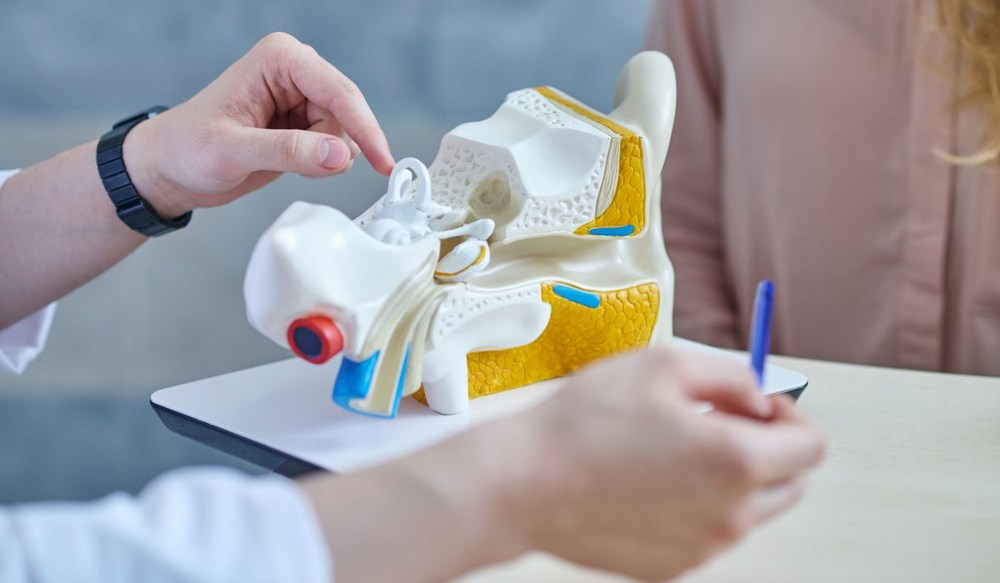How to Create a Hearing-Friendly Home Environment
Your home should feel comfortable for conversation, but hearing loss can

By: admin | January 26, 2025
When it comes to hearing clearly, we all want simple solutions. Just like reading glasses became available at local stores, over-the-counter hearing aids are now an option for many people experiencing mild to moderate hearing loss. This change means you can take a first step toward better hearing without waiting for multiple appointments.
You might notice when family conversations become harder to follow, or when you keep turning up the TV volume. These everyday moments remind us how important hearing is – it connects us to our loved ones and helps us stay engaged in daily activities.
While OTC hearing aids offer a new path to hearing help, they’re just one part of the picture. Think of them as an introduction to hearing care, similar to how some people start with drugstore readers before seeing an eye doctor. Working with a hearing professional is still the best way to protect your hearing health and get the most out of any hearing device.
OTC (over-the-counter) hearing aids are a newer option for individuals who experience self-perceived, mild hearing loss. Approved by the U.S. Food and Drug Administration (FDA) in October 2022, these devices are designed to be purchased without a prescription or a visit to a hearing care professional. The idea behind OTC hearing aids is to make hearing assistance more accessible – particularly for those who may be hesitant to seek professional help or who want to take a first step toward addressing their hearing concerns.
These hearing aids allow users to self-fit and adjust the devices to their preferences, making them an entry point for people just starting to explore the idea of hearing aids. While they can be beneficial for certain individuals, it’s important to approach OTC hearing aids thoughtfully. Professional instruction and guidance can enhance the benefits of these devices – helping users get the most out of them and ensuring they’re being used safely and effectively.
For many, OTC hearing aids serve as a way to become more comfortable with the idea of wearing a hearing aid, providing a stepping stone toward improved hearing health. However, for those with more significant or complex hearing needs, prescription hearing aids – custom-fitted and tailored to specific hearing profiles – remain the best solution.
OTC hearing aids have a simple yet effective design. They amplify sounds to make them more audible for the wearer. They use microphones to pick up environmental sounds, enhance certain frequencies and deliver them into your ears through speakers.
However, while they can enhance sound levels for those with mild to moderate hearing loss, they lack the personalized adjustments provided by prescription models. Each person’s hearing loss is unique in terms of severity and affected frequencies. To address this effectively, a consultation with a hearing health professional is necessary.
PSAPs are devices designed to amplify sound for individuals in specific listening environments, like birdwatching, attending a lecture or hearing a distant conversation. Unlike hearing aids, PSAPs are not regulated by the FDA as medical devices and are not intended to address hearing loss. They simply boost all sounds indiscriminately and do not include features to enhance speech clarity or reduce background noise.
OTC hearing aids, on the other hand, are FDA-regulated devices specifically designed to help individuals with self-perceived, mild hearing loss. These devices are intended for everyday use, improving speech comprehension and managing hearing challenges in various environments. Unlike PSAPs, OTC hearing aids are equipped with advanced features, like the ability to adjust settings for personalized amplification or better speech understanding.
The key difference lies in purpose and functionality. While PSAPs are a general sound enhancement tool, OTC hearing aids are designed to address hearing loss in a more targeted and regulated way. For those experiencing hearing difficulties, OTC hearing aids offer a more tailored and appropriate solution, whereas PSAPs are not meant to substitute for hearing aids.
Prescription hearing aids are advanced, customizable devices designed to address a wide range of hearing needs. Unlike OTC hearing aids, prescription hearing aids are fitted and fine-tuned by a hearing care professional. This ensures the device is tailored specifically to your hearing profile, lifestyle and preferences, offering a level of precision and personalization that OTC options cannot match.
These devices come in a variety of styles, from discreet in-the-ear (ITE) models to versatile behind-the-ear (BTE) designs. Depending on your level of hearing difficulty and preferences, your hearing care professional will help you select the style that best suits your needs. For example, BTE models often accommodate more powerful hearing aid technology and additional features, while ITE options are more compact and less noticeable.
Prescription hearing aids also incorporate advanced features to enhance the hearing experience. Many models include directional microphones for better focus on speech, feedback suppression to reduce unwanted sounds and connectivity options that allow seamless integration with smartphones, TVs and other devices. Some models even offer rechargeable batteries, eliminating the need to replace them frequently.
What truly sets prescription hearing aids apart is the level of support you receive. Your specialist will guide you through the entire process, from the initial hearing test to ongoing adjustments and maintenance. This professional care ensures that your hearing aids not only fit comfortably but also function optimally in various environments, providing the clarity and confidence needed to navigate daily life.
Modern OTC hearing aids have made significant progress in recent years, offering greater accessibility and convenience for individuals with mild, self-perceived hearing loss. These advancements aim to improve usability and functionality while providing an approachable starting point for those exploring hearing solutions.
One major improvement in OTC hearing aids is the addition of customizable settings. Many models now connect to smartphone apps, allowing users to adjust volume levels, sound profiles and basic background noise reduction. These options make it easier to tailor the device to different environments, like quiet home settings or louder social gatherings.
Sound processing in OTC hearing aids has also become more advanced, focusing on enhancing clarity and reducing distracting background noises. While these devices are not intended for more complex hearing needs, they offer improved performance for mild hearing issues, giving users better speech understanding in straightforward listening situations.
Design and comfort have also seen updates, with sleeker, more discreet options that fit comfortably behind or inside the ear. Features like rechargeable batteries further add to their convenience, making them a practical choice for everyday use.
While OTC hearing aids provide a helpful introduction to hearing care, they are not a substitute for the tailored performance and professional adjustments that prescription hearing aids offer. These developments, however, demonstrate a growing commitment to making hearing solutions more accessible for everyone.
In the world of OTC hearing aids, there are several types to choose from, each with its unique features and benefits.
One common type is the BTE model. Known for their durability and ease of use, they’re a favorite among many users. Another option is the ITE model. These devices offer discretion due to their less visible placement. The ITE model fits partly in the ear canal, providing an even less noticeable solution with excellent sound quality.
Each type has its strengths and weaknesses depending on what you’re looking for – be it durability, discretion or ease-of-use. Consulting with a qualified hearing professional can guide you towards choosing the right device based on your needs and lifestyle.
When considering OTC hearing aids, it’s important to weigh their advantages and limitations to determine if they’re the right choice for your hearing needs. OTC hearing aids provide a convenient, more accessible option for individuals with mild, self-perceived hearing loss. However, they differ significantly from prescription devices in customization, support and long-term care.
One of the biggest advantages of OTC hearing aids is that they’re readily available, allowing users to purchase and set them up without waiting for a professional appointment. For those with mild hearing difficulties, this accessibility can be an excellent starting point to address their hearing challenges. Many OTC models also include features like smartphone app integration, giving users control over basic settings like volume and sound profiles.
That said, OTC devices lack the highly personalized approach that comes with prescription hearing aids. Prescription devices are carefully calibrated by a professional to match your specific hearing needs, taking into account a detailed hearing evaluation and your unique lifestyle. This professional adjustment ensures that the device amplifies the sounds you need most while minimizing background noise and enhancing speech clarity in complex environments.
Another important factor is ongoing support. With prescription hearing aids, you benefit from follow-up care, adjustments and troubleshooting provided by your hearing care provider, ensuring your devices continue to meet your needs over time. OTC hearing aids, while convenient, leave much of this responsibility to the user. Without professional guidance, it may be harder to achieve optimal hearing results or address any issues that arise.
Ultimately, the choice between OTC and prescription hearing aids depends on your individual hearing needs and the level of customization and support you value. For those with mild hearing concerns who are comfortable with self-management, OTC devices can be a good starting point. However, for individuals seeking tailored performance and professional care, prescription hearing aids offer unmatched benefits.
When choosing a hearing device, talking to a hearing care provider is one of the most important steps you can take. A hearing care professional doesn’t just assess your hearing levels; they also help you identify the type of hearing device that fits your specific needs. Unlike OTC devices, which rely on self-assessment, a specialist uses precise diagnostic tools to evaluate your hearing health. They then tailor a prescription hearing aid to amplify the frequencies where you experience the most difficulty, ensuring the device supports your unique lifestyle and hearing goals.
Additionally, working with a professional gives you access to ongoing care and adjustments. Your hearing needs may evolve over time, and prescription devices can be fine-tuned to accommodate those changes. Hearing care providers also provide guidance on selecting features like directional microphones, noise reduction or Bluetooth connectivity, ensuring your device aligns with your daily activities.
Taking steps to improve your hearing is an important decision, and having options like OTC hearing aids makes it easier to start. But for personalized care and long-term support, working with a hearing professional remains invaluable. At Beltone Hearing Care Centre, with locations across British Columbia, we’re here to help you navigate your hearing health and find the right solution for your needs.
Whether you’re exploring OTC devices or considering prescription hearing aids, our team provides the expertise and guidance to ensure you’re hearing at your best. Your hearing is too important to leave to guesswork – give us a call today and take the next step toward clearer, more confident communication.
Tags: benefits of hearing aids, hearing aid styles, over-the-counter hearing aids

Your home should feel comfortable for conversation, but hearing loss can
By: admin | November 17, 2025

Your hearing test results do much more than just tell you whether you have
By: admin | September 24, 2025

When hearing becomes difficult, the right professional makes all the
By: admin | May 23, 2025